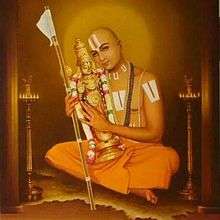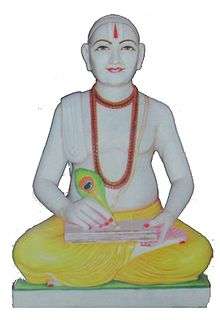Bairagi (caste)
Bairagi (Swami) is a caste of Hindus and is known by names like Vaishnav Brahmin, Swamiji or Swami, Babaji, Bawa, Dixit and Pujari at different places in India. They follow one of four orders: the Visishtadvaita belief system of Ramanuja (popularized by Ramananda in North India); the Dvaitadvaita philosophy propagated by Nimbarkacharya; the Shuddhadvaita philosophy propagated by Vishnuswami (mostly popularised by Vallabhacharya in North India); or the Dvaita philosophy propagated by Madhvacharya.


According to these philosophies, people are divided into four main sampradaya (religious systems):
- Shri Sampradaya[1]
- Nimbarka Sampradaya (Kumar Sampradaya)[2]
- Rudra Sampradaya[3]
- Brahma Sampradaya.
Mostly members of the Bairagi community perform priesthood practices in temples. These people are known as:
- Vaishnava Brahmin
- Swami
- Mahant
- Pujari
- Gossain or Goswami (mostly used Vaishnav of Bengal and Vallabhacharya Vaishnav Sampradaya)
Now Bairagi community people usually work in agriculture or as landlords.
Origin
The name Bairagi is derived from the Sanskrit word vairagya, which means, "one who is free from worldly affairs".
Identification of Bairagi
A Bairagi is one whose principal deity is Vishnu or either of his great incarnations: Rama or Krishna. The caste spread throughout India, but they are more concentrated in the northwestern states of the country. Bairagis can be identified by their necklaces of Tulsi beads and their tilak, (a spot of colored powder or paste worn on the forehead, known as Urdhva Pundra). The Bairagi are vegetarian but avoid masur dal (lentil), onion, and garlic.
There are 52 gotras (clans) and 52 dwaras (schools) of Vaishnavas. They follow the dual gotra system: Vaishnava Acharya gotra and Rishi gotra, i.e. Kiladevacharya (Kilavat) and Kaushik gotra are gotras of the same clan. There are also some non-Brahmin Bairagis who joined the community during the Bhakti movement.
Bairagi dynasties and states
The first ruler Mahant Ghasi Das, was recognized as a feudal chief by the British government in 1865 and was granted a sanad of adoption. Later the British conferred the title of raja on the ruling mahant.[4][5]
Bairagi or Vairagi akharas
Notable people
- Tulsidas (Ramanandi - Sri Sampradaya)[7]
- Surdas (Vallabhachari Sampradaya)
- Chaitanya Mahaprabhu (propounder of Gaudiya Vaishnavism)
See also
References
- Chandrakanta (10 December 2017). Katha Satisar. Rajkamal Prakashan Pvt Ltd.
- "निम्बार्क संप्रदाय - भारतकोश, ज्ञान का हिन्दी महासागर". Bharatdiscovery.org. Retrieved 10 December 2017.
- Rosen, Steven (10 December 1994). Vaisnavism. Motilal Banarsidass.
- Chhattisgarh ki Riyaste/Princely stastes aur Jamindariyaa. Raipur: Vaibhav Prakashan. ISBN 81-89244-96-5.
- Chhattisgarh ki Janjaatiyaa/Tribes aur Jatiyaa/Castes. Delhi: Mansi publication. ISBN 978-81-89559-32-8.
- [South Asian Religions on Display: Religious Processions in South Asia and in the Diaspora, Knut A. Jacobsen, ISBN hardback 978-0-415-4373-3, ISBN ebook ISBN hardback 978-0-203-93059-5]
- Rambhadracharya 2008, pp. xxvi–xxix.
